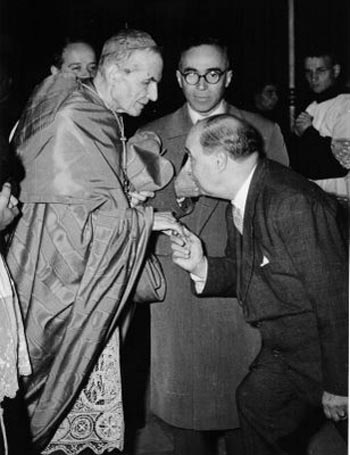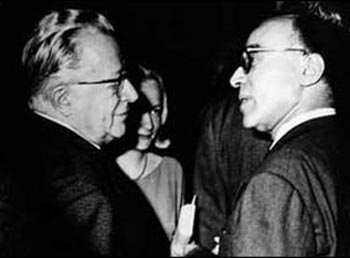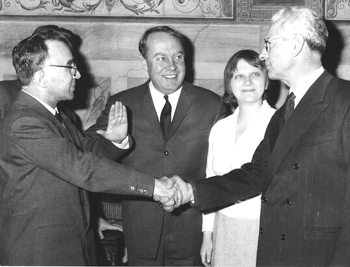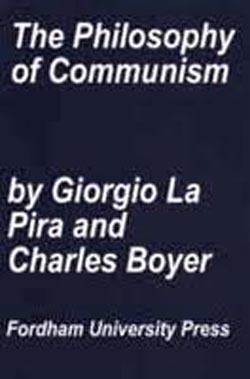Socio-Political Issues
 |
 |
 |
 |
 |
 |
 |
La Pira: A Catholic Communist - Part II
He Was the Link between
the Vatican & the Kremlin
Instead of being in the forefront in the battle against Soviet totalitarianism, Giorgio La Pira was busy sending up trial balloons for the rehabilitation of Communism in the West. Between 1952 and 1956 – some years before the Pact of Metz and the opening of Vatican II – he started by organizing Conferences on Civilization and Peace in Florence with goals similar to that of the Sillon – the concept of universal brotherhood among all religions as the foundation of political action for the social progress of humanity.
 His aim, in his own words, was “to begin a new history of a thousand years of civilisation and peace. A civilisation and a peace destined to refract fully onto the earth the loving light of the fatherhood of God and the brotherhood of men.” (1)
His aim, in his own words, was “to begin a new history of a thousand years of civilisation and peace. A civilisation and a peace destined to refract fully onto the earth the loving light of the fatherhood of God and the brotherhood of men.” (1)
This was only the warming up process for a bolder initiative – his 1955 Conference of Mayors of Capital Cities in Florence, at which he unfolded his plan for “peace of the cities of the entire world … which makes a pact of brotherhood at the very basis of the life of Nations.” (2)
The sting in the tail was the presence of Mayors from six communist countries at the Conference. La Pira invited them, together with the Soviet Ambassador to Italy, to a special Mass celebrated by his good friend, Card. Elia dalla Costa, in the Franciscan Basilica of Santa Croce.
For La Pira, the purpose of the Mass was far removed from the worship of God or the conversion of the communists. “The important thing,” he stated, “is that we have all come together here, each in his own way, wishing for peace and welfare and that we all together attended Mass, and all shook hands with a Cardinal who is truly a saint.” (3)
La Pira’s collusion with communists
The presence of the Soviet Ambassador Semyon P. Kozyrev as La Pira’s guest speaks volumes about the latter’s relationship with the Communist Party of Italy (CPI). As the intermediary between the Kremlin and the CPI, the Ambassador was in daily contact with Palmiro Togliatti who headed the CPI, and La Pira capitalized on his contacts with them in order to further his progressivist agenda.
 At the top of his list was his quest for a political program of cooperation between Catholics and Communists to achieve peace and unity among all peoples, and he wrote many letters to Togliatti to establish dialogue between the Church and Communism. On December 25, 1947, for example, he wrote to Togliatti:
At the top of his list was his quest for a political program of cooperation between Catholics and Communists to achieve peace and unity among all peoples, and he wrote many letters to Togliatti to establish dialogue between the Church and Communism. On December 25, 1947, for example, he wrote to Togliatti:
“The controversial relation between these two problems [that is to say Communism and Catholic Church] is the real essence of the modern crisis and anxiety.” (4) This “alienation” could be solved, according to La Pira, by uniting the philosophy of Marxism with Christian metaphysics.
Such a program played straight into the hands of the Soviet Ambassador and Togliatti who both wanted to establish links with the Catholic Church for purposes of infiltration and domination.
In fact, so close was the collusion between La Pira and Moscow that in 1956 Ambassador Kozyrev gave La Pira a secret preview of Khruschev’s famous report denouncing Stalin to the CPSU [Communist Party of Soviet Union] months before it was released to the western world. La Pira confirmed this fact: “Yes, it’s true: the Russian Ambassador handed the report to me in a monastery in Florence.”(5)
 It was through the intermediary of the Soviet Ambassador Kozyrev that in February 1963 La Pira was able to facilitate a meeting between Pope John XXIII and Khruschev’s daughter Rada and son-in-law Alexei Adjubei, editor-in-chief of the Soviet newspaper, Izvestiya. It was a surprise visit for the Vatican, but not for La Pira: immediately before the meeting, he had received the two Russians in the Palazzo Vecchio in Florence.(6)
It was through the intermediary of the Soviet Ambassador Kozyrev that in February 1963 La Pira was able to facilitate a meeting between Pope John XXIII and Khruschev’s daughter Rada and son-in-law Alexei Adjubei, editor-in-chief of the Soviet newspaper, Izvestiya. It was a surprise visit for the Vatican, but not for La Pira: immediately before the meeting, he had received the two Russians in the Palazzo Vecchio in Florence.(6)
At this meeting, Pope John XXIII had his photo taken shaking the hand of Adjubei, resulting in a massive boost in the popularity of the CPI among Catholics. In the general election of April 1963, the CPI won over 25% of the total votes.
The La Pira-Togliatti-Stalin triangle
It is hardly a surprise, therefore, to learn that La Pira had a personal line of communication with Stalin (and later Khruschev) through his Soviet patrons in Italy. The Russian Ambassador was well-placed as an intermediary: He received his instructions directly from the International Department of the Central Committee of the Soviet Communist Party (CPSU), and any information he obtained from La Pira through his friendly contacts would have been relayed straight back to Moscow.
La Pira made use of his friendship with Togliatti in 1951 when, after a meeting with Togliatti who was about to leave for Moscow, he asked him to transmit a message to Stalin for a political solution to the War in Korea. (7) We have every reason to be skeptical about this arrangement, given La Pira’s aversion to America and the U.S. intervention in the Korean War.
 After Pius XII issued his Decree against Communism on July 1, 1949, excommunicating all Catholics who collaborate in communist organizations, Stalin, realizing that a frontal attack on Catholicism would be futile, personally instructed Togliatti that the PCI should moderate its approach to the Church in Italy. Instead of open aggression, he said, the Party should spread the idea of how “the wealth and the ruling position of integral Christianity are at odds with the message of the Gospel.” (8)
After Pius XII issued his Decree against Communism on July 1, 1949, excommunicating all Catholics who collaborate in communist organizations, Stalin, realizing that a frontal attack on Catholicism would be futile, personally instructed Togliatti that the PCI should moderate its approach to the Church in Italy. Instead of open aggression, he said, the Party should spread the idea of how “the wealth and the ruling position of integral Christianity are at odds with the message of the Gospel.” (8)
It was in this area of propaganda that La Pira helped Togliatti to persuade Catholics that holders of wealth and power are fundamentally enemies of the Gospel and that Catholics and communists should cooperate to promote “evangelical poverty” in society. This was La Pira’s – as well as Togliatti’s and Stalin’s – strategy to neutralize anti-communist opposition and reduce Catholic hegemony without appearing to be anti-Catholic. It was also a backhanded way of combating Capitalism with Marxism disguised as Catholic teaching.
The more we know about this over-cozy relationship, the more scandalous it becomes. But La Pira did not seem to be perturbed by the thought that cozying up to representatives of one of the world’s most brutal regimes that practiced persecution and genocide on millions of innocent people is nothing short of moral bankruptcy.
He must have known that Togliatti was no friend of the Catholic Church. Since 1927, Togliatti had held the position of CPI leader and was Stalin’s emissary to the Spanish Communist Party, which persecuted the Church during the Spanish Civil War. He had also been Stalin’s henchman during the Great Purges and trials that liquidated countless “enemies of the revolution.”
The toll included Italian nationals – fellow countrymen of both Togliatti and La Pira – who had fled to Moscow during the Mussolini regime. They either died in the Gulags or were executed after a summary trial in the Stalinist Terror. (9) The salient factor here is that Togliatti was not just an enforcer of these acts but, as a leader of the Executive Committee of the Communist International, also directly responsible for them.
“No, I am not afraid of the communists,” La Pira once declared to Dorothy Day. (Catholic Worker, June 1963) Given this demonstration of blind insouciance in the face of danger, we are prompted to ask: What made La Pira so confident that if even Italian anti-fascists were liquidated by Togliatti he himself would be spared in the event of a communist take-over of Italy?
Continued

Posted April 1, 2013

La Pira standing to the right of Card. dalla Costa
This was only the warming up process for a bolder initiative – his 1955 Conference of Mayors of Capital Cities in Florence, at which he unfolded his plan for “peace of the cities of the entire world … which makes a pact of brotherhood at the very basis of the life of Nations.” (2)
The sting in the tail was the presence of Mayors from six communist countries at the Conference. La Pira invited them, together with the Soviet Ambassador to Italy, to a special Mass celebrated by his good friend, Card. Elia dalla Costa, in the Franciscan Basilica of Santa Croce.
For La Pira, the purpose of the Mass was far removed from the worship of God or the conversion of the communists. “The important thing,” he stated, “is that we have all come together here, each in his own way, wishing for peace and welfare and that we all together attended Mass, and all shook hands with a Cardinal who is truly a saint.” (3)
La Pira’s collusion with communists
The presence of the Soviet Ambassador Semyon P. Kozyrev as La Pira’s guest speaks volumes about the latter’s relationship with the Communist Party of Italy (CPI). As the intermediary between the Kremlin and the CPI, the Ambassador was in daily contact with Palmiro Togliatti who headed the CPI, and La Pira capitalized on his contacts with them in order to further his progressivist agenda.

La Pira was in constant contact with Communist Party Secretary Togliatti, at left
“The controversial relation between these two problems [that is to say Communism and Catholic Church] is the real essence of the modern crisis and anxiety.” (4) This “alienation” could be solved, according to La Pira, by uniting the philosophy of Marxism with Christian metaphysics.
Such a program played straight into the hands of the Soviet Ambassador and Togliatti who both wanted to establish links with the Catholic Church for purposes of infiltration and domination.
In fact, so close was the collusion between La Pira and Moscow that in 1956 Ambassador Kozyrev gave La Pira a secret preview of Khruschev’s famous report denouncing Stalin to the CPSU [Communist Party of Soviet Union] months before it was released to the western world. La Pira confirmed this fact: “Yes, it’s true: the Russian Ambassador handed the report to me in a monastery in Florence.”(5)

La Pira, left, arranged for Krushev's daughter Rada and husband Alexei, center, to meet with John XXIII
At this meeting, Pope John XXIII had his photo taken shaking the hand of Adjubei, resulting in a massive boost in the popularity of the CPI among Catholics. In the general election of April 1963, the CPI won over 25% of the total votes.
The La Pira-Togliatti-Stalin triangle
It is hardly a surprise, therefore, to learn that La Pira had a personal line of communication with Stalin (and later Khruschev) through his Soviet patrons in Italy. The Russian Ambassador was well-placed as an intermediary: He received his instructions directly from the International Department of the Central Committee of the Soviet Communist Party (CPSU), and any information he obtained from La Pira through his friendly contacts would have been relayed straight back to Moscow.
La Pira made use of his friendship with Togliatti in 1951 when, after a meeting with Togliatti who was about to leave for Moscow, he asked him to transmit a message to Stalin for a political solution to the War in Korea. (7) We have every reason to be skeptical about this arrangement, given La Pira’s aversion to America and the U.S. intervention in the Korean War.

La Pira co-authored a book promoting a 'Christian' Communism
It was in this area of propaganda that La Pira helped Togliatti to persuade Catholics that holders of wealth and power are fundamentally enemies of the Gospel and that Catholics and communists should cooperate to promote “evangelical poverty” in society. This was La Pira’s – as well as Togliatti’s and Stalin’s – strategy to neutralize anti-communist opposition and reduce Catholic hegemony without appearing to be anti-Catholic. It was also a backhanded way of combating Capitalism with Marxism disguised as Catholic teaching.
The more we know about this over-cozy relationship, the more scandalous it becomes. But La Pira did not seem to be perturbed by the thought that cozying up to representatives of one of the world’s most brutal regimes that practiced persecution and genocide on millions of innocent people is nothing short of moral bankruptcy.
He must have known that Togliatti was no friend of the Catholic Church. Since 1927, Togliatti had held the position of CPI leader and was Stalin’s emissary to the Spanish Communist Party, which persecuted the Church during the Spanish Civil War. He had also been Stalin’s henchman during the Great Purges and trials that liquidated countless “enemies of the revolution.”
The toll included Italian nationals – fellow countrymen of both Togliatti and La Pira – who had fled to Moscow during the Mussolini regime. They either died in the Gulags or were executed after a summary trial in the Stalinist Terror. (9) The salient factor here is that Togliatti was not just an enforcer of these acts but, as a leader of the Executive Committee of the Communist International, also directly responsible for them.
“No, I am not afraid of the communists,” La Pira once declared to Dorothy Day. (Catholic Worker, June 1963) Given this demonstration of blind insouciance in the face of danger, we are prompted to ask: What made La Pira so confident that if even Italian anti-fascists were liquidated by Togliatti he himself would be spared in the event of a communist take-over of Italy?
Continued
- Quoted by La Pira’s friend, Vittorio Citterich, ‘The "holy mayor" and the powerful of the world’, Oasis, 2 September 2005
- See here
- Catholic Herald, December 29, 1961. See here
- Marco Salvatore Paolino, Catholic Church, Holy See and Communism. From Divini Redemptoris to Ost-Politik. International scenario and Italian experience.
- 30 Days Magazine, Februrary 2004, Giulio Andreotti, ‘The Extraordinary La Pira’, his speech given at the memorial service of Giorgio La Pira in the Palace of Montecitorio on February 25, 2004
- See here
- See here
- Stalin’s words are quoted in A. Agosti, Palmiro Togliatti, Turin: Unione Tipografico-Editrice Torinese, 1996, p. 373
- Elena Agarossi and Victor Zaslavsky, Stalin and Togliatti: Italy and the Origins of the Cold War Cold War, Stanford University Press, 2011, have consulted thousands of unpublished documents from the Moscow Archives on the fate Italian political prisoners, who were largely militant anti-Fascists, communists, socialists, and anarchists before falling victim to Stalin's purges
- Douglas Hyde, ‘Dangerous New Tactics in Italy’, Catholic Herald, September 2, 1955.

Posted April 1, 2013
______________________
______________________











